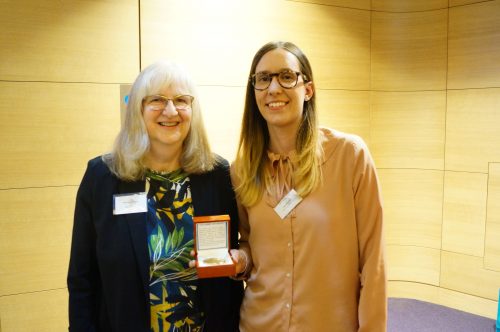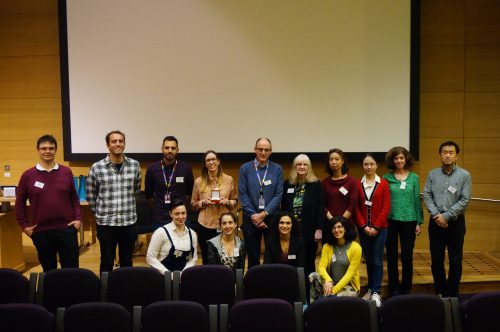The Young Embryologist Network Conference 2019: Meeting Summary
Posted by Alex Eve, on 24 May 2019
Since the Young Embryologist Network (YEN) was established in 2008, its annual conference grows from strength to strength, and thanks to the introduction of travel grants in 2017, the YEN meeting now welcomes an international delegation of attendees studying a variety of developmental problems. YEN conferences are special because they organised by early-career researchers for early-career researchers, which creates a distinctive atmosphere of support, collaboration and discussion. I attended the YEN meetings many times during my PhD and PostDoc, and last week I was happy to join again on behalf of Development to celebrate the 11th annual conference. It was the second year that the one-day event was hosted at the Francis Crick Institute, where it featured three invited speakers, 12 selected speakers, around 30 poster presentations and a panel discussion on careers.
One of the common themes of the day was morphogenesis. Florence Giger presented on the dynamics of forebrain neurulation, using live-imaging to investigate myosin localisation during zebrafish neural tube closure. At the opposite end of the embryo, Lewis Thomson explored the dynamics of the zebrafish presomitic mesoderm, which decreases in every dimension during axis elongation. Similarly, Toby Andrews translated morphology into quantitative data in order to understand axis elongation in amphioxus, and used lineage-tracing experiments to identify axial progenitor cells. Sally Lowell (one of the invited speakers) also quantified morphogenesis and, in her opening talk, revealed new tools to measure epithelial formation in the primitive streak1. Sally explained how morphological changes to tissues can help cells commit to changes in gene expression by manipulating the 3D organisation of epiblast stem cells with micropatterns2. You can find out more about her work in “The people behind the papers” interview with Sally, and her colleagues and collaborators, here on the Node.
In recent years, the YEN conferences have hosted a celebration of the memory of Sammy Lee, a prominent scientist in the field of IVF and a great supporter of early career researchers. This year’s Sammy Lee Memorial Lecture was given by keynote speaker Takashi Hiiragi, who returned to the role of forces during development by demonstrating the role of cortical tension in mouse blastocoel self-organisation and fluid cavities in regulating tissue size3,4. Also working in the pre-implantation embryo, Claudia Gerri showed a conserved molecular cascade during blasocyst formation in the mouse, human and cow. Claudia received the Sammy Lee Award for her talk, which is presented to one of the speakers for an “outstanding piece of research”. The medal was awarded by Sammy’s wife Karen Lee, who was one of the judges along with David Wilkinson and Karen Liu. Also keeping in early mammalian development, Sergio Menchero explained the role of Notch signalling in driving the transition for pre-implantation differentiation5, and you can read the story behind the paper here on the Node. Notch also featured in Valeria Scagliotti‘s talk on the pituitary gland, where she showed that overexpression of Dlk1 increases the proliferation of anterior pituitary gland progenitors.

Many of the speakers are interrogating how cells make decisions. Systems biologist and invited speaker Jordi Garcia-Ojalvo proposed using recurrent neural networks to explain how gene regulatory networks can achieve “memory” of their past multidimensional inputs during differentiation6. Noelia Muñoz-Martín discussed the role of Myc7 and MEIS transcription factors in murine cardiac development, and showed that knockdown of MEIS genes affects calcium signalling. Joana Silva discussed the requirement of the mRNA capping enzyme, CMTR1, during pluripotent cell differentiation in embryoid bodies, and Eleni Chrysostomou presented her research in the hydroid, Hydractinia using fluorescent reporter lines to unpick the roles of SoxB family genes in the differentiation of stem cells to neurons. Sergi Junyent Espinosa revealed the neuronal-like properties of stem cells, which utilise synapse-like interactions to find their niche. Andreas Sagner revealed the dynamics of mouse spinal cord development, using single-cell sequencing data from the developing neural tube8 and won a runner-up prize for his talk. The second runner-up Can Aztekin discussed his work — also involving single-cell sequencing — to identify a new population of cells (ROCs) required for Xenopus tail regeneration9.
The talks concluded with a careers panel discussion featuring Marta Gritti (Senior Editor at EBioMedicine, Elsevier), Andy Powell (Crick, GSK Biomedical LinkLabs), Graham Mills (Co-founder and Managing Director of Techspert), and Silvia Santos (Group Leader at the Crick). The panel talked about their career paths and the responsibilities in their current roles, as well as answering questions from the audience about job security, the necessity of moving abroad, the value of internships, the first steps to starting a new career, and opportunities to return to academia. Overall, the panel agreed that we should do what we like doing, for as long as we want — or are able — to do it!
For the first time, all attendees were invited to vote for their favourite posters. The first place poster prize was awarded to Yan Liang for her poster on appendage repression during the evolution of crustaceans and insects — well done! Congratulations to the runners up: Cato Hastings for her poster on mathematical modelling of the primitive streak and Andrea Szydlo-Shein for her poster on neuronal organisation in the zebrafish visual system.

Throughout the conference I was impressed with the good pace of the talks, the openness of speakers to share unpublished data and new ideas, and their receptiveness for feedback on their research. The conference finished with a drinks reception and the opportunity for the attendees to relax and discuss the topics of the day. Congratulations to the prize winners, thank you to the speakers and, most importantly, a huge thank you to the YEN committee for organising the meeting and all their hard work behind the scenes.
If you’d like to know more about the science during the meeting, check out the Twitter @YEN_community, the hashtags #YENconf2019 & #YEN2019, or see the associated preList!
1Blin et al. NesSys: a novel method for accurate nuclear segmentation in 3D. bioRxiv 2018. doi: https://doi.org/10.1101/502872
2Blin et al. Geometrical confinement controls the asymmetric patterning of brachyury in cultures of pluripotent cells. Development 2018; 145: dev166025. doi: 10.1242/dev.166025
3Chan et al. Hydraulic control of embryo size, tissue shape and cell fate. bioRxiv 2018. doi: https://doi.org/10.1101/389619
4Kim et al. Coordination of Cell Polarity, Mechanics and Fate in Tissue Self-organization. Trends Cell Biol 2018. doi: https://doi.org/10.1016/j.tcb.2018.02.008
5Menchero et al. Transitions in cell potency during early mouse development are driven by Notch. eLife 2019;8:e42930. doi: 10.7554/eLife.42930
6Gabalda-Sagarra et al. Recurrence-based information processing in gene regulatory networks. Chaos 2018; 28(10):106313. doi: 10.1063/1.5039861
7 Noelia Muñoz-Martín et al. Myc is dispensable for cardiomyocyte development but rescues Mycn-deficient hearts through functional replacement and cell competition. Development 2019; 146: dev170753 doi: 10.1242/dev.170753
8Delile et al. Single cell transcriptomics reveals spatial and temporal dynamics of gene expression in the developing mouse spinal cord. Development 2019; 146: dev173807 doi: 10.1242/dev.173807
9Aztekin et al. Identification of a regeneration-organizing cell in the Xenopus tail. Science 2019; 364(6441), 653-658. doi: 10.1126/science.aav9996


 (3 votes)
(3 votes)